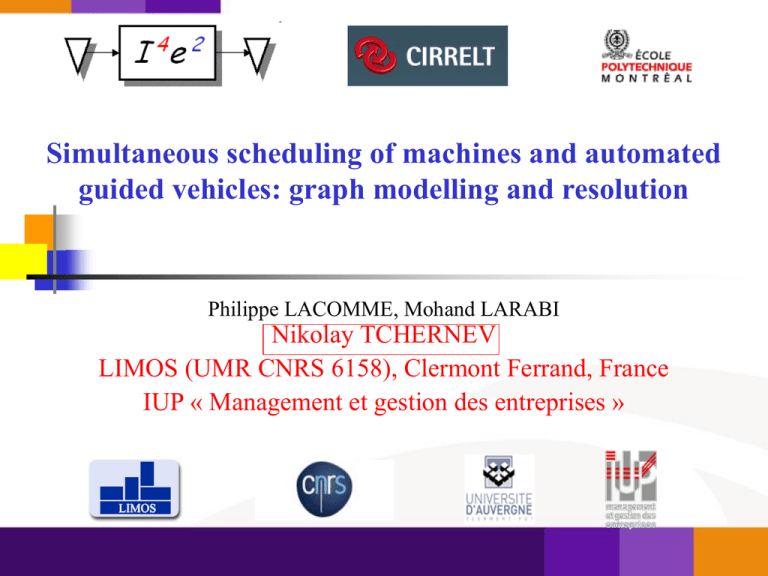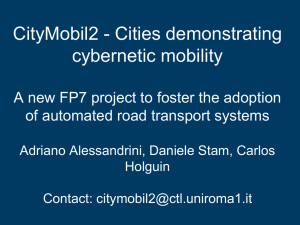0 - ISIMA
advertisement

Simultaneous scheduling of machines and automated guided vehicles: graph modelling and resolution Philippe LACOMME, Mohand LARABI Nikolay TCHERNEV LIMOS (UMR CNRS 6158), Clermont Ferrand, France IUP « Management et gestion des entreprises » Simultaneous scheduling of machines and automated guided vehicles: graph modelling and resolution Plan Plan Introduction Algorithm based framework Computational evaluation Conclusions and further works IESM 2009, MONTREAL – CANADA, May 13 TR 2 Simultaneous scheduling of machines and automated guided vehicles: graph modelling and resolution Introduction Type of system under study: FMS based on AGV FMS definition IESM 2009, MONTREAL – CANADA, May 13 TR 3 Simultaneous scheduling of machines and automated guided vehicles: graph modelling and resolution Introduction Type of system under study: FMS based on AGV AGV system Guide path layout Automated Guided Vehicles IESM 2009, MONTREAL – CANADA, May 13 TR 4 Simultaneous scheduling of machines and automated guided vehicles: graph modelling and resolution Introduction Type of system under study: FMS based on AGV Flexible machines IESM 2009, MONTREAL – CANADA, May 13 TR 5 Simultaneous scheduling of machines and automated guided vehicles: graph modelling and resolution Introduction Type of system under study: FMS based on AGV Flexible cells IESM 2009, MONTREAL – CANADA, May 13 TR 6 Simultaneous scheduling of machines and automated guided vehicles: graph modelling and resolution Introduction Type of system under study: FMS based on AGV Input/Output buffers IESM 2009, MONTREAL – CANADA, May 13 TR 7 Simultaneous scheduling of machines and automated guided vehicles: graph modelling and resolution Introduction AGV operating (1/2) Loaded vehicle arriving at station k Unloading at station k Loaded vehicle arriving at station i IESM 2009, MONTREAL – CANADA, May 13 Loading at station k Unloading at station i Loaded vehicle going to station .... Idle vehicle at station i TR 8 Simultaneous scheduling of machines and automated guided vehicles: graph modelling and resolution Introduction AGV operating (2/2) Empty vehicle arriving at station j Loading at station j Loaded vehicle going to station .... There are two types of vehicle trips: the first type of loaded vehicle trips ; the second one is the empty vehicle trips. IESM 2009, MONTREAL – CANADA, May 13 TR 9 Simultaneous scheduling of machines and automated guided vehicles: graph modelling and resolution Introduction Problem definition (1/5) Problem definition The scheduling problem under study can be defined in the following general form: Given a particular FMS with several vehicles and a set of jobs, the objective is to determine the starting and completion times of operations for each job on each machine and the vehicle trips between machines according to makespan or mean completion time minimization. IESM 2009, MONTREAL – CANADA, May 13 TR 10 Simultaneous scheduling of machines and automated guided vehicles: graph modelling and resolution Introduction Problem definition (2/5) Problem definition : Example of solution Empty trip IESM 2009, MONTREAL – CANADA, May 13 TR 11 Simultaneous scheduling of machines and automated guided vehicles: graph modelling and resolution Introduction Problem definition (3/5) Problem definition : Complexity Combined problem of: (i) scheduling problem of the form n / M / G / Cmax (n jobs, M machines, G general job shop, Cmax makespan), a well known NP-hard problem (Lenstra and Rinnooy Kan 1978); (ii) a generic Vehicle Scheduling Problem (VSP) which is NP-hard problem (Orloff 1976). IESM 2009, MONTREAL – CANADA, May 13 TR 12 Simultaneous scheduling of machines and automated guided vehicles: graph modelling and resolution Introduction Problem definition (4/5) Problem definition : Assumptions in the literature All jobs are assumed to be available at the beginning of the scheduling period. The routing of each job types is available before making scheduling decisions. All jobs enter and leave the system through the load and unload stations. It is assumed that there is sufficient input/output buffer space at each machine and at the load/unload stations, i.e. the limited buffer capacity is not considered. Vehicles move along predetermined shortest paths, with the assumption of no delay due to the congestion. Machine failures are ignored. Limitations on the jobs simultaneously allowed in the shop are ignored. IESM 2009, MONTREAL – CANADA, May 13 TR 13 Simultaneous scheduling of machines and automated guided vehicles: graph modelling and resolution Introduction Problem definition (5/5) Under these hypotheses the problem can be without doubt modelled as a job shop with several transport robots. JR t kl , t kl' Cmax notation introduced by Knust 1999 J indicates a job shop, R indicates that we have a limited number of identical vehicles (robots) and all jobs can be transported by any of the robots. t kl indicates that we have job-independent, but machine- dependant transportation times. t kl' indicates that we have machine-dependant empty moving time. The objective function to minimize is the makespan . IESM 2009, MONTREAL – CANADA, May 13 TR 14 Simultaneous scheduling of machines and automated guided vehicles: graph modelling and resolution Algorithm based framework General template General template interface Instance to solve and framework parameters Best solution Memetic algorithm MTS and OA Non oriented disjunctive graphe One solution evaluation Longest path algorithm IESM 2009, MONTREAL – CANADA, May 13 Oriented disjunctive graphe TR 15 Simultaneous scheduling of machines and automated guided vehicles: graph modelling and resolution Algorithm based framework Disjunctive graph definition (1/3) Non oriented disjunctive graph G VM Vt , C Dm DR consists of: Vm : a set of vertices containing all machine operations; Vt : a set of vertices containing all transport operations; C : representing precedence constraints in the same job; Dm : containing all machine disjunctions; Dr : containing all transport disjunctions. IESM 2009, MONTREAL – CANADA, May 13 TR 16 Simultaneous scheduling of machines and automated guided vehicles: graph modelling and resolution Algorithm based framework Disjunctive graph definition (2/3) J1 M2 7 M3 5 M1 4 0 J2 J3 0 0 M3 0 M5 5 5 IESM 2009, MONTREAL – CANADA, May 13 M4 M1 4 5 M1 1 * 3 M3 TR 17 Simultaneous scheduling of machines and automated guided vehicles: graph modelling and resolution Algorithm based framework Disjunctive graph definition (2/2) Machine disjunction problem Robot disjunction problem M2 8 r1 M3 5 r2 M1 4 0 0 0 M3 0 M5 5 r1 5 M4 M1 4 5 M1 1 * 3 M3 Robot assignment problem IESM 2009, MONTREAL – CANADA, May 13 TR 18 Simultaneous scheduling of machines and automated guided vehicles: graph modelling and resolution Algorithm based framework Disjunctive graph definition (3/3) To obtain an oriented disjunctive graph we must : define a job sequence on machines ; define an assignment of robots to each transport operation ; define a precedence (order) to transport operations assigned to one robot. Using two vectors: MTS which defines Machine and Transport Selections OA which defines Operation Assignments to each robot IESM 2009, MONTREAL – CANADA, May 13 TR 19 Simultaneous scheduling of machines and automated guided vehicles: graph modelling and resolution Algorithm based framework Disjunctive graph orientation (1/2) m2 m3 m5 MTS 1 2 3 m1 m1 m3 m3 m4 m1 1 2 3 1 2 3 1 Transport operations M2 0 0 M3 5 0 M5 5 IESM 2009, MONTREAL – CANADA, May 13 5 M3 5 0 1 3 2 3 Transport operations 7 0 2 4 5 M4 2 M1 7 M1 5 4 5 4 M1 2 1 * 3 M3 TR 20 Simultaneous scheduling of machines and automated guided vehicles: graph modelling and resolution Algorithm based framework Disjunctive graph orientation (2/2) tr11 tr21 tr31 MTS 1 2 3 1 2 3 Machine operations M2 7 0 7 0 0 0 r1 M3 5 M5 1 2 r1 r3 3 Machine operations 2 2 2 1 5 M1 1 3 2 3 r2 3 M1 4 5 M4 2 Machine operations M3 5 0 5 tr12 tr22 tr32 3 4 5 r2 r3 5 3 2 4 M1 1 * 3 M3 OA r1 r1 r3 r2 r2 r3 tr11 tr21 tr31 tr12 tr22 tr32 IESM 2009, MONTREAL – CANADA, May 13 TR 21 Simultaneous scheduling of machines and automated guided vehicles: graph modelling and resolution Algorithm based framework Graph evaluation and Critical Path Makespan =24 0 M2 7 7 0 r1 7 0 0 M3 5 0 M5 14 r1 5 5 r3 IESM 2009, MONTREAL – CANADA, May 13 2 2 5 M3 5 0 0 2 9 M4 7 M1 r2 17 3 M1 4 5 16 14 3 4 5 5 20 r2 12 r3 3 2 4 23 M1 14 24 1 * 3 M3 TR 22 Simultaneous scheduling of machines and automated guided vehicles: graph modelling and resolution Algorithm based framework Memetic algorithm begin npi := 0 ; // current iteration number ni := 0 ; // number of successive unproductive iteration Repeat SelectSolution (P1,P2) C := Crossover(P1,P2) LocalSearch(C) with probability pm InsertSolution(Pop,C) Sort(Pop) If (npi=np) Restart(Pop,p) End If Until (stopCriterion). End IESM 2009, MONTREAL – CANADA, May 13 interface Instance to solve and framework parameters Best solution Memetic algorithm MTS and OA Non oriented disjunctive graphe One solution evaluation Longest path algorithm Oriented disjunctive graphe TR 23 Simultaneous scheduling of machines and automated guided vehicles: graph modelling and resolution Algorithm based framework Chromosome Chromosome is a representation of a solution m2 m3 m5 tr11 tr21tr31 m3 m4 m1 tr12tr22tr32 m1 m1 m3 MTS 1 2 3 1 2 3 OA r1 r1 r3 r2 r2 r3 1 2 3 1 2 3 1 2 3 tr11 tr21 tr31tr12 tr22 tr32 Makespan = 24 IESM 2009, MONTREAL – CANADA, May 13 TR 24 Simultaneous scheduling of machines and automated guided vehicles: graph modelling and resolution Algorithm based framework Local search (1/5) For one iteration: Change one machine disjunction orientation (in the critical path) OR Change one robot disjunction orientation (in the critical path) OR Change one robot assignment. IESM 2009, MONTREAL – CANADA, May 13 TR 25 Simultaneous scheduling of machines and automated guided vehicles: graph modelling and resolution Algorithm based framework Local search (2/5) Change transport disjunction m2 m3 m5 tr11 tr21 tr31 m3 m4 m1 tr12 tr22 tr32 m1 m1 m3 MTS OA 1 2 3 1 2 3 1 2 3 r1 r1 r3 r2 r2 r3 1 2 1 3 2 3 Robot block tr11 tr21 tr31 tr12 tr22 tr32 0 M2 7 7 0 r1 74 0 M3 5 0 M5 14 r1 5 5 r3 IESM 2009, MONTREAL – CANADA, May 13 2 2 5 M3 5 0 0 0 2 9 M4 7 M1 r2 17 3 M1 4 5 16 14 3 4 5 5 20 r2 12 r3 3 2 4 23 M1 14 24 1 * 3 M3 TR 26 Simultaneous scheduling of machines and automated guided vehicles: graph modelling and resolution Algorithm based framework Local search (3/5) Change machine disjunction m2 m3 m5 tr21 tr11 tr31 m3 m4 m1 tr12 tr22 tr32 m1 m1 m3 MTS OA 1 2 3 2 1 3 1 2 3 1 2 1 3 2 Machine block r1 r1 r3 r2 r2 r3 3 Makespan =23 tr21 tr11 tr31 tr12 tr22 tr32 0 M2 8 7 0 r1 3 0 0 M3 5 0 M5 5 r1 5 5 r3 IESM 2009, MONTREAL – CANADA, May 13 2 2 5 M3 5 0 0 2 10 M4 7 M1 r2 18 3 M1 4 5 7 15 3 4 5 5 18 r2 12 r3 3 2 4 22 M1 15 23 1 * 3 M3 TR 27 Simultaneous scheduling of machines and automated guided vehicles: graph modelling and resolution Algorithm based framework Local search (4/5) m2 m3 m5 tr21 tr11 tr31 m3 m4 m1 tr12 tr22 tr32 m1 m1 m3 MTS OA 1 2 3 2 1 3 1 2 3 r1 r3 r1 r3 r2 r2 r3 1 2 1 3 2 3 Change robot assignement tr21 tr11 tr31 tr12 tr22 tr32 0 M2 8 7 0 r1 3 0 0 M3 5 0 M5 5 r3 r1 5 5 r3 IESM 2009, MONTREAL – CANADA, May 13 2 2 5 M3 5 0 0 2 10 M4 7 M1 r2 18 3 M1 4 5 7 15 3 4 5 5 18 r2 12 r3 3 2 4 22 M1 15 23 1 * 3 M3 TR 28 Simultaneous scheduling of machines and automated guided vehicles: graph modelling and resolution Algorithm based framework Local search (5/5) m2 m3 m5 tr21 tr11 tr31 m3 m4 m1 tr12 tr22 tr32 m1 m1 m3 MTS OA 1 2 3 2 1 3 1 2 3 r1 r3 r1 r3 r2 r2 r3 1 2 1 3 2 3 Change robot assignement tr21 tr11 tr31 tr12 tr22 tr32 0 M2 7 7 2 r1 0 0 M3 5 5 r3 r1 2 5 M3 5 0 0 9 M4 r2 17 3 M1 4 5 7 14 3 4 5 17 r2 3 4 21 M1 22 1 * 4 0 0 M5 9 5 r3 2 11 M1 5 16 r3 2 18 3 M3 New transport disjunction is added IESM 2009, MONTREAL – CANADA, May 13 TR 29 Simultaneous scheduling of machines and automated guided vehicles: graph modelling and resolution Computational evaluation Instances Two types of experiments have been done using well known benchmarks in the literatures. The first type of experiments concerns instances of: Hurink J. and Knust S., "Tabu search algorithms for job-shop problems with a single transport robot", European Journal of Operational Research, Vol. 162 (1), pp. 99-111, 2005. The second one with two identical robots from: Bilge, U. and G. Ulusoy, 1995, A Time Window Approach to Simultaneous Scheduling of Machines and Material Handling System in an FMS, Operations Research, 43(6), 1058-1070. IESM 2009, MONTREAL – CANADA, May 13 TR 30 Simultaneous scheduling of machines and automated guided vehicles: graph modelling and resolution Computational evaluation Experimental results (1/4) Experiments on job-shop with one single robot on Hurink and Knust instances based on well-known 6x6 and 10x10 instances: J.F. Muth, G.L. Thompson, Industrial Scheduling, Prentice Hall, Englewood Cliffs, NJ, 1963. Deviation in percentage from the best solution found by each method to lower bound proposed by Hurink and Knust Four methods proposed by Hurink and Knust 13,40 16,16 IESM 2009, MONTREAL – CANADA, May 13 14,22 16,63 Our method 13,33 TR 31 Simultaneous scheduling of machines and automated guided vehicles: graph modelling and resolution Computational evaluation Experimental results (2/4) Experiments on Bilge & Ülusoy (1995) 40 instances 4 machines, 2 vehicles 10 jobsets, 5 - 8 jobs, 13 - 23 operations 4 different structures for FMS IESM 2009, MONTREAL – CANADA, May 13 TR 32 Simultaneous scheduling of machines and automated guided vehicles: graph modelling and resolution Computational evaluation Experimental results (3/4) Exemple of FMS structure M1 M2 M3 M4 LU IESM 2009, MONTREAL – CANADA, May 13 TR 33 Simultaneous scheduling of machines and automated guided vehicles: graph modelling and resolution Computational evaluation Experimental results (4/4) Instances [7] BFS DEV% 114 114 0 Ex11 90 90 0 Ex12 98 98 0 Ex13 140 140 0 Ex14 116 116 0 Ex21 82 82 0 Ex22 89 89 0 Ex23 134 134 0 Ex24 121 121 0 Ex31 89 89 0 Ex32 96 96 0 Ex33 148 148 0 Ex34 138 138 0 Ex41 100 100 0 Ex42 102 102 0 Ex43 163 163 0 Ex44 110 110 0 Ex51 81 81 0 Ex52 89 89 0 Ex53 134 134 0 Ex54 IESM 2009, MONTREAL – CANADA, May 13 Instances [7] BFS DEV% 129 129 0 Ex61 102 102 0 Ex62 105 105 0 Ex63 151 151 0 Ex64 134 134 0 Ex71 86 86 0 Ex72 93 93 0 Ex73 161 161 0 Ex74 167 167 0 Ex81 155 155 0 Ex82 155 155 0 Ex83 178 178 0 Ex84 129 127* -1,55 Ex91 106 106 0 Ex92 107 107 0 Ex93 149 149 0 Ex94 153 153 0 Ex101 139 139 0 Ex102 141 139* -1,42 Ex103 183 183 0 Ex104 TR 34 Simultaneous scheduling of machines and automated guided vehicles: graph modelling and resolution Conclusion and further works Conclusion Step forwards the generalization of the disjunctive graph model including several robots; Memetic algorithm based approach for a generalization of the job-shop problem; Specific properties are derived from the longest path to generate neighbourhoods; IESM 2009, MONTREAL – CANADA, May 13 TR 35 Simultaneous scheduling of machines and automated guided vehicles: graph modelling and resolution Conclusion and further works Further works Additional constraints; Axact methods; Larger instances; IESM 2009, MONTREAL – CANADA, May 13 TR 36








